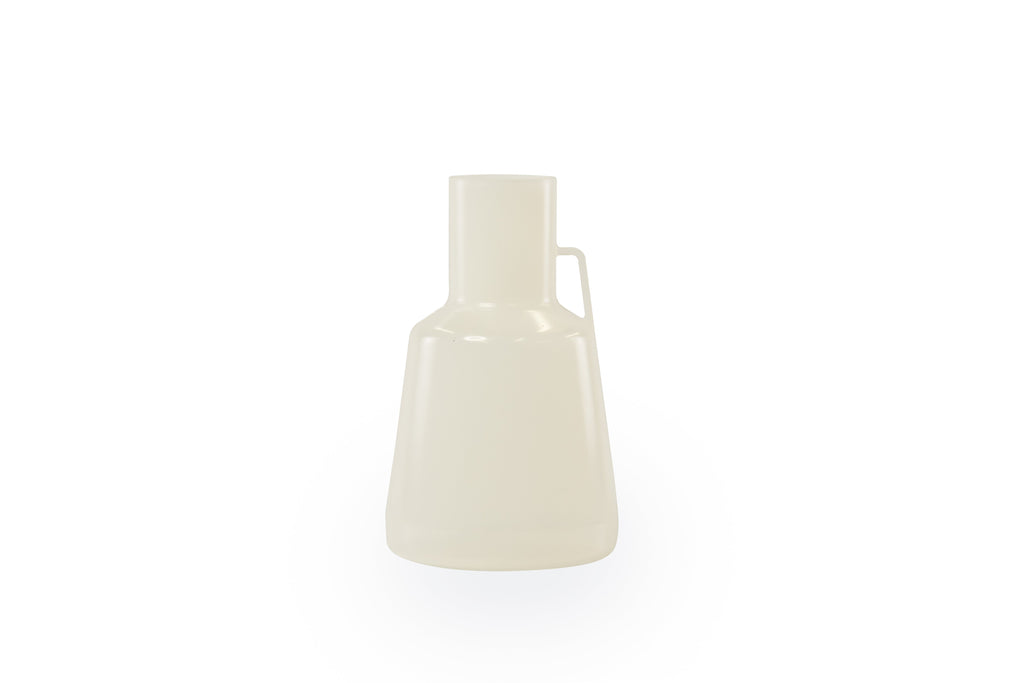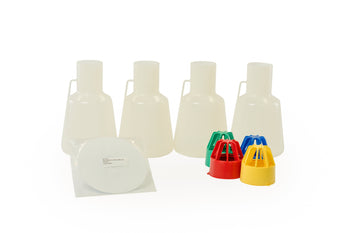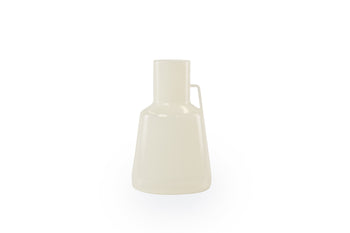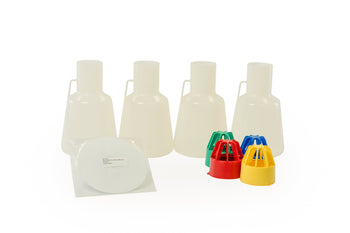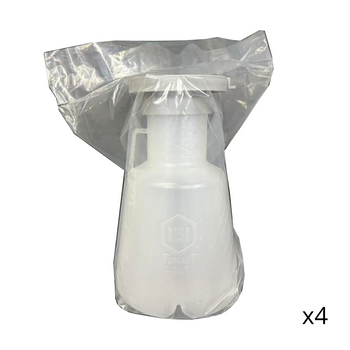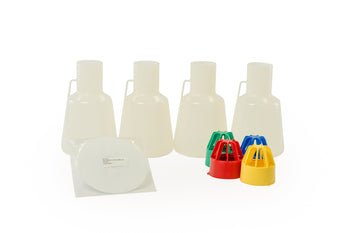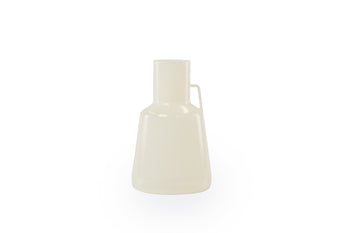
TUNAIR™ Polypropylene Erlenmeyer Flasks: The Ultimate Solution for Optimal Growth
IBI's TUNAIR™ polypropylene Erlenmeyer flask system is a patented and innovative solution designed to optimize microbiology and biotechnology applications. These advanced Erlenmeyer flasks create the ideal environment for the cultivation of aerobic microorganisms, mammalian cells, and plant cells, promoting superior growth conditions and higher productivity compared to standard laboratory flasks. With a specialized design that enhances oxygen transfer and aeration, these flasks are engineered to deliver reliable, consistent, and reproducible results in various research and industrial settings. The Half-Baffle shake flask has two baffles that produce a vortex motion.
One of the defining characteristics of TUNAIR™ Erlenmeyer flasks is their high oxygen absorption capability, made possible by an innovative baffling system and a turbo-vane closure design. This feature significantly increases the availability of dissolved oxygen, ensuring enhanced cell yields and optimized culture conditions. Unlike conventional Erlenmeyer flasks, which may limit oxygen transfer, the TUNAIR™ system enables more efficient gas exchange, leading to improved microbial growth, better aeration for mammalian and plant cell cultures, and increased overall productivity.
These flasks are suitable for a wide range of laboratory applications, including microbial fermentation, bioprocessing, and cell culture research. Whether used in academic research, pharmaceutical development, or industrial biotechnology, the TUNAIR™ polypropylene Erlenmeyer flask provides the precision and reliability needed for critical scientific work. The thoughtful engineering of these flasks makes them especially useful for studies requiring optimal oxygenation, including high-density bacterial growth and cell lysis processes.
Best Quality Flasks for Your Lab:
Crafted from high-quality, durable polypropylene, TUNAIR™ Erlenmeyer flasks are resistant to most solvents, making them highly reliable for various laboratory conditions. Their robust construction ensures long-term usability without compromising performance, even in chemically challenging environments. These flasks are also designed for ease of use and maintenance, as they can be cleaned by soaking in water with a mild detergent solution, followed by air drying. Additionally, the TUNAIR™ system offers various options, including specialized caps and filters, to enhance aeration and contamination control.
By integrating efficiency, reliability, and innovation, TUNAIR™ polypropylene Erlenmeyer flasks provide laboratories with a superior alternative to standard shake flasks. Their ability to maximize culture growth, improve oxygen transfer, and maintain optimal environmental conditions makes them an essential tool for scientists and researchers aiming for high-performance results. Upgrading to TUNAIR™ Erlenmeyer flasks ensures a significant enhancement in bioprocessing efficiency, reproducibility, and overall laboratory productivity.
- Accessories
- Specifications
- Technical Information
Flask Dimensions:
Flask Size: 2.5 L
Working Volume: 1 L
Base Diameter: 6.50” [16.51 cm]
Neck Diameter: 3.00” [7.62 cm]
Height: 10.75” [27.31 cm]
Height with cap in place = 12.75"
Weight: 0.02 lbs. [0.008 Kg]
Mixing:
Half-Baffle (2 Baffles): Vortex Motion
Shaker Speed:
1” Throws: 300-400 rpm or possibly higher
2” Throws: 150-200 rpm or possibly higher
Material:
All TUNAIR flasks and caps are constructed of chemical resistant polypropylene. All flasks and caps are fully autoclavable.
300 ml flask:
Allows for approx. 150 ml (max) of working volume for culturing cells
2.5 Liter flask:
Allows for approx. 1 liter (max) of working volume for culturing cells
Half-Baffle:
The bottom inside of the flask has 2 raised baffles. This configuration will generate a single vortex within the media inside the flask when fastened to an orbital shaker. The half-baffle configuration will allow for slower operational rpm of the shaker while maintaining the single vortex. Less splashing occurs with the half-baffle flask which results in less cell death and higher cell densities.
Two Piece Cap:
The 300 ml flask and 2.5 L flask both have a special cap and filter system that promotes gas exchange and maintains sterility of the growth culture during use. The inner portion of the cap unsnaps from the outer portion by pushing in the tabs on the side of the cap assembly and then pulling the insert out.
0.2-micron filters:
There are two different types of 0.2-micron filters available for the TUNAIR flasks. These filters allow for maximum gas exchange while maintaining sterility.
Dri-Gauze – This is a paper filter than can be used approx. 6 to 8 times before having to be replaced. This filter can be autoclaved while in the cap, on the flask, for 6 to 8 times.
Silicone – This is a silicone filter that will last the life of the flask. This filter can be autoclaved while in the cap and on the flask for many times.
Cap & Filter assembly:
Once you have the 2-piece cap assembly apart (either the 300 ml cap or the 2.5 L cap) place the corresponding filter size inside the cap and the re-assemble the inner and outer cap pieces making certain to align the tabs with their associated holes. Once clipped into place, make certain the filter completely covers the cap assembly openings.
Attaching the flasks to your shaker:
IBI TUNAIR flasks can be used with nearly all standard shakers and shaker clamps. The 2.5-liter flask typically fits best into the 2-liter shaker clamp. The 300 ml flask typically fits best in the 250 ml shaker clamp.
Preparing and Cleaning the TUNAIR flask:
Your TUNAIR flasks are constructed of polypropylene plastic which allows them to be autoclaved. Once you have prepared your media inside the flask you can place the cap & filter on the flask and insert into the autoclave. Set the autoclave for wet cycle.
Once you have harvested your cells, wash the TUNAIR flask in a mild dish soap such as Dove Dish Soap then rinse well with DI water. Do NOT rinse the Dri-Gauze filter between uses. The silicone filter can also be rinsed with DI water if needed. Observe the condition of the filters between runs to make certain there are no holes or tears in the filter. If there are, replace the filter immediately.
Cell Growth Evaluation of Commonly Used Shake Flasks:
TUNAIR™ flasks were compared to conventional flasks using four different types of microorganisms; Escherichia coli, Saccharomyces cerevisiae, Penicillium avellaneum, and Streptomyces chartreusis. The aeration capacities of the shake flasks were determined by the sulfate oxidation method, and the values shown below are presented as oxygen absorption rate (OAR) in mM oxygen/L/Min. The growth rates of E.coli and S.cerevisiae were expressed as optical densities (OD) at 555 mM. For S.chartreusis and P.avellaneum growth rates were evaluated by percent sedimentation. For E.coli and S.cerevisiae, the growth rates were determined after an 18-hour incubation period; for S.charteusis, a 24-hour incubation period; and for P.avellaneum, a 72-hour incubation period. Growth and OAR evaluations were carried out with 3-9 replicates and statistically analyzed using Turkey’s w-procedure. See results below.
Growth Chart:
| OAR Value | OD @ 555 mM | % Sedimentation | |||
|---|---|---|---|---|---|
| Flask | mM O2/L/Min. | E.coli | S.cerevisiae | S.chartreusis | P.aveilaneum |
| TUNAIR™ Full-Baffle | 4.25 | 7.09 | 5.63 | 19.7 | 3.3 M |
| TUNAIR™ Half-Baffle | 1.22 | 5.36 | 5.57 | 27.73 | 30.50 P |
| Triple Indented Flasks | 2.47 | 5.97 | 5.31 | 19.20 | 9.50 MP |
| Unbaffled Erlenmeyer | 0.52 | 5.97 | 5.19 | 17.37 | 25.10 P |
Growth Morphology:
M, mycelial; P, pellet; MP, mixed mycelial. The mycelial growths mostly adhered to the walls of the flask, which accounted for the low overall sedimentation value.
Reference Papers:
1. Method to Increase the Yield of Eukaryotic Membrane Protein Expression inSaccharomyces Cerevisiae
2. Optimisation of Recombinant Production of Active Human Cardiac SERCA2a ATPase

